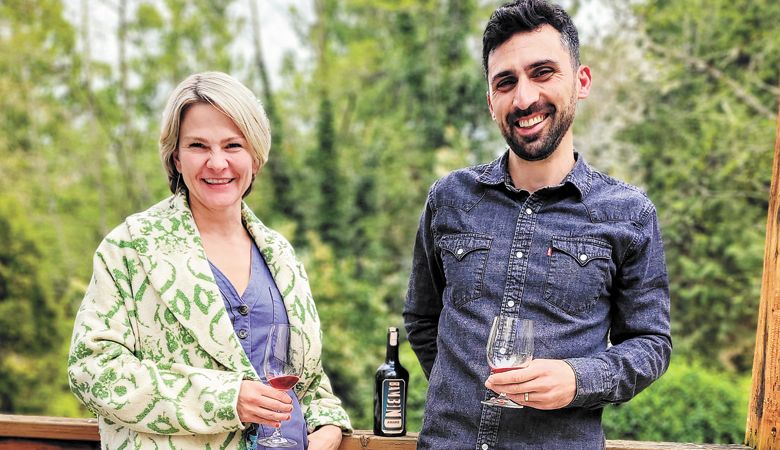Bittersweet Bambino
Amaro the perfect end to dinner and a column
A new amaro from Day Wines is the best Bambino deal since the Yankees stole Babe Ruth from the Red Sox for $100,000.
A century after that famous coup, Colin Howard was settling into his new job as Brianne Day’s assistant winemaker. His most challenging 2020 harvest task: using his spirits expertise and a batch of smoke-damaged Pinot Noir to help Day fulfill her dream of making an amaro, which translates to bitter in Italian.
According to Howard, formerly a head distiller at House Spirits in Portland: “Modern amari extend from the family of Italian bittered liqueurs that use different botanicals, fruits and other flavors that are macerated in a neutral spirit and/or wine, then sweetened to taste.”
The plural for amaro is amari. It’s interesting how the Italian words for bitter and love are so similar.
Day first toyed with making an amaro with a smoke-impacted Southern Oregon wine in 2017. Unfortunately, the brandy she made with the wine didn’t quite match the desired profile. “I didn’t know what I was doing back then. With Colin on board, we were able to develop a professional protocol to make this amaro work,” Day says.
Bambino Amaro ($56 for 500 ml) started life as 1,500 gallons of smoke-damaged Willamette Valley Pinot Noir. Day handed it off to Freeland Spirits, where they cooked it down to 120 gallons, clocking in at 150% alcohol by volume (ABV). “The higher proof pulls out the candied fruit and juniper flavors you wouldn’t get at lower levels. It’s not a bitter liqueur, it is a bittered liqueur that we wanted to taste good and like the Pacific Northwest,” Howard explains.
The 15 botanicals used to make Bambino include juniper, coriander seeds, rosemary, fennel seeds, star anise, hand-picked cherries, strawberries and blueberries. The dried fruit component uses orange and lemon peels. Galangal root and cinchona bark were used as bittering agents.
Day and Howard spent weeks of blending trials to reach the proper balance between the wine base, botanicals, bittering agents and sugar. Toward the end of the process, they added a barrel of 2020 Johan Vineyards Pinot to boost acidity and amplify the overall fresh fruit qualities.
I’m glad Day and Howard took their shot. Bambino is the freshest, most fruit-forward amaro I’ve ever had the “buona fortuna” to sip.
Bambino’s cloudy red color reminds me of strawberry jam as it slowly slides down the sides of the glass after a good swirl. Those thick rivulets aren’t ordinary wine legs; those are Cristiano Ronaldo legs.
Aromatically, I’m not sure where to begin. If I told you every little thing I picked up over the course of the evening, it might just fill this magazine.
It starts with scents of licorice, crystallized ginger, Sanpellegrino Aranciata Rossa and cherry compote. Then the sweet and herbal floral notes of lavender and jasmine take over. More glass swirls pull earthier tones that conjure memories of spreading cedar bark mulch in the spring. The more I swirled, the more my notebook filled.
Finally, I gave up and started sipping. The salted licorice note will make any Finn happy. The little touches of graham crackers and Christmas spices will make your inner child smile.
The list of fruit flavors is long, with quince and dried orange peel duking it out with raspberry fruit leather and strawberry gelato for supremacy. Fresh mint and hibiscus tea flavors hover in the background.
Bambino’s texture feels rich without being viscous. It has sweetness without being cloying. And, at 28% ABV, it casts a warm glow without serious heat. There is a sense of balance here.
Bambino also contains the acidity needed to feel energetic and lively, which is perfect given its namesake. Originally this amaro was named Viggo in honor of Day’s boisterous young son, but Vigo Amaro made in Pennsylvania dashed those plans, so Viggo became Bambino.
Use Bambino to make a variety of cocktails or sip it straight after a meal. I prefer the latter, a perfect way to end an evening.
As far as endings go, Hilary Berg is easily one of the best editors I’ve ever worked for. Best wishes and a “Rock Chalk” to Hilary and her family.
This is also my 65th and final column. I thank Hilary from the bottom of my heart for the opportunity. Thanks to all of you for reading along. Please keep exploring Oregon’s less-traveled wine roads to find new thrills. If anyone out there knows a publisher willing to roll the dice on yet another wine book, give me a holler.










